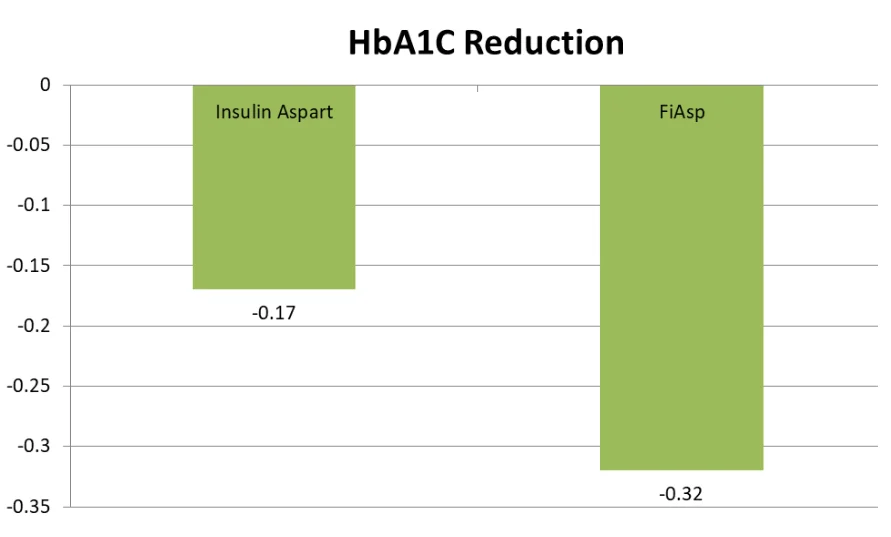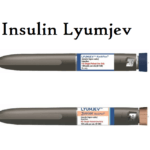Insulin Aspart vs Insulin Lispro is a comparison of two ultra-short-acting insulin. Both these insulins have been formulated further into very-rapid-acting insulins as well. “FiASP” is “faster Insulin Aspart) and Lispro-aabc or Insulin Lyumjev is the newly formulated Insulin Lispro.
All insulins have the same mechanism of action. They lower blood glucose by enhancing the entry of glucose present in the plasma into the cells.
The primary target cells for insulin to act on are those of the skeletal muscles and the fat cells. Along with that, insulin also reduces hepatic glucose output and inhibits the breakdown of lipids and proteins.
All insulins, when administered in doses exceeding the required dose can result in hypoglycemia. They may cause lipo-hypertrophy when administered repeatedly in one area.
Some patients may also notice a hypersensitivity reaction to insulin or insulin analogs.
Insulin Lispro Vs Aspart – Comparing Pharmacokinetics:
Insulin Lispro | Insulin Aspart | |
| Brand Names | Humalog | Novorapid |
| Formulations |
|
|
Newer Formulations | Insulin Lyumjev or Insulin Lispro-aabc | FiAsp (Faster Aspart) |
Bioavailability | 55% – 75% | 80% |
Half-Life: | One hour | 70 – 80 minutes |
The onset of action: | 15 minutes | 10 to 15 minutes |
Duration of action: | Less than 5 hours | 4 to 5 hours |
Time to peak plasma concentration | One hour | 40 – 50 minutes |
Insulin Lispro and Lispro-aabc Vs Aspart and FiAsp – Structural Differences:
Insulin Lispro is structurally different from human insulin as it has lysin instead of proline in position 28 and proline in position 29 instead of lysine in the Beta chains.
Insulin Lispro-aabc or Insulin Lyumjev is similar in structure to insulin Lispro, however, citrate and treprostinil are added to its structure which increases its absorption.
Insulin Aspart differs from human insulin as it has aspartic acid instead of proline at position B28.
Insulin FiAsp or Faster Aspart is similar to insulin Aspart except for the addition of niacinamide (vitamin B3), which enhances its absorption when it is administered subcutaneously.
Insulin Lispro vs Aspart – Which Insulin is more effective?
Insulin Lispro and Aspart are both rapid-acting insulins. Few clinical trials have directly compared Insulin Lispro and Aspart.
In a study conducted on patients with Type 1 Diabetes Mellitus, both insulin Lispro and Aspart resulted in similar insulin levels after 30 minutes of their administration, and the levels returned to baseline after 4 hours.
There were no differences in Plasma glucose levels, ketones, free fatty acids, and insulin requirements in patients receiving insulin Lispro or Aspart [Ref].
Similar results were demonstrated in other studies as well. The pharmacodynamics and pharmacokinetic parameters of insulin Aspart and Lispro were found equivalent in both groups.
Mean plasma glucose reduction, postprandial plasma glucose, and insulin requirements were similar in both groups.
Two patients in the insulin Aspart group and five patients in the insulin Lispro group developed hypoglycemia requiring glucose infusion.
Statistical tests did not show any significant difference between the incidence of hypoglycemia in the two groups [Ref].
FiAsp Vs Aspart Insulin:
FiAsp is a modified form of Insulin Aspart. The addition of vitamin B3 to the structure of Insulin Aspart results in its rapid onset of action and rapid absorption via the skin when administered into the skin.
FiAsp was studied in comparison to Insulin Aspart in both T1DM and T2DM patients. Superior glycemic efficacy as measured by HbA1C and postmeal glucose was observed with FiAsp especially when both insulins were administered at mealtime or immediately after meals.

Both Insulin Aspart and FiAsp had comparable side effects, including the incidence of hypoglycemia.
Insulin Lispro Vs Insulin Lyumjev:
Similar results were observed in the Pronto-T1DM and Pronto-T2DM comparing Insulin Lyumjev (Insulin Lispro-aabc) with Insulin Lispro. Both insulins had a comparable safety profile and efficacy.
Insulin Lyumjev was non-inferior to insulin Lispro in reducing glycated hemoglobin. However, postmeal hyperglycemia was better controlled with Insulin Lyumjev or Insulin Lispro-aabc [Ref].
Insulin Aspart vs Insulin Lispro: Dosing and Conversion:
Both Insulin Aspart and Insulin Lispro are rapid-acting insulins. The usual dose of all rapid and short-acting insulins is calculated based on the total daily dose.
Generally, the total daily insulin dose is divided into two. Half (50%) of the dose is administered as basal insulin (Glargine, Detemir, or Degludec). The remaining 50% dose is divided into three doses and administered before each meal.
These doses are then adjusted based on the patient’s meals, activities, and body weight.
Insulin Aspart and Lispro Dose Calculation:
For example, an 80 kg person is started on insulin. The starting dose is calculated as 0.4 – 0.5 units/kg per day.
0.5 x 80 = 40 units per day. Half (20 units) will be given as basal insulin. The other 20 units will be divided into three doses as 7 + 6 + 7 or 7 + 7 + 6 depending on which meal is the heaviest meal of the day or the lightest meal of the day.
Another method of initiating insulin is weight in pounds divided by 4. For example, 176 pounds (80 kg) is divided by 4 = 44 units.
Half of 44 units = 22 will be given as basal insulin. The remaining 22 units will be divided into three equal doses 8 + 7 + 7 and administered before each meal.
Dosing Conversion from Insulin Aspart to Insulin Lispro:
Insulin Aspart can be converted into Insulin Lispro in a ratio of 1:1. This means a person taking 10 units of insulin Aspart can use 10 units of Insulin Lispro.
In Summary:
Insulin Lispro and Aspart have similar safety profiles and efficacies in achieving glycemic control. However, the newer formulation of Insulin Aspart (FiAsp) and Lispro (Lyumjev or Lispro-aabc) were observed to better control postmeal hyperglycemia.






